|
   |
|
Page 7 |
Newsletter 126 Autumn 2019 © Hampshire Mills Group |
|
Siabost Norse Mill and Drying Kiln, Isle of Lewis
Ivor New
|
|
In early May my brother and I set off on a tour of
the Islands and Highlands of Scotland. It was the
week after the famous spring heatwave and there was
a complete reversal in the weather. When the sun
was out it was glorious; unfortunately the amount
of full sun was at least equalled by the rain, hail,
sleet and snow, the remaining time being overcast.
Not the best of weather when you are travelling in
a camper. We did not get down-hearted, just
accepted the walking we intended to do would be
curtailed and we would just have to spend more time
at tourist attractions and sampling the fare
provided by the local hostelries. |
|
We found the Norse Mill at Siabost (Shawbost) by
following the brown tourist road sign. The location
of the mill is dictated by the course of the nearby
stream which flows out of Loch Roinavat. This is
not unusual as many similar mills were built on
streams fed by lochs and it is easy to find ruins in
this sort of location that could well have been
mills. |
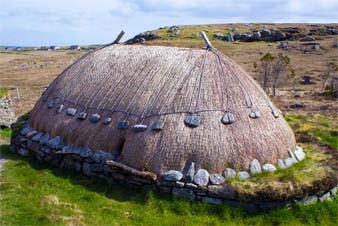 |
|
These mills provide an insight into the life of the
poor on Lewis and other small communities in the
Highlands and Islands. Historically these
communities had attributes that can well be
described as feudal and life was hard. Early on
there were clearances forcibly imposed on the
Jacobite supporting communities for political
reasons but later the pressures were economic. In
common with other poorer areas in Europe the very
existence of this type of community became
problematical as the social pressures produced by
the Industrial Revolution became more intense and
landowners increasingly found their tenants were
unable to generate income, causing the established
way of living to become untenable.
At other times differing pressures provided the main
catalyst for the depopulation, the two most
significant immediate causes being famine and
unemployment. The Irish potato famine is well
recognised but the potato blight, fed by a decade of
poor harvests, spread over the poorer areas of
Scotland and much of mainland Europe. The results
were the same – starvation and emigration. The
Industrial Revolution also led to depopulation of
the countryside and the improvements in hygiene led
to an increase in population with no proportional
increase in income to support it, which only
increased hardship.
The reactions of the land-owners varied from blatant
disregard for their ex-tenants to providing them
with some support. We found two examples of
landlords that actively followed the latter path.
In one case tenants were provided with passage to
Canada to join established Scottish communities
where free land was available. (I’m not trying to
justify colonialism, just acknowledging the
provision of a new life for impoverished people.)
In the other case the landowner built a new harbour
for fishing boats with associated housing, thus
making available food and income for the surviving
population.
In general, the net result was that countless
small communities were lost, although some managed
to survive well into the 20th century. These were
in the minority and most such hamlets have
completely disappeared from sight, becoming
indistinguishable and overgrown in the landscape. There
were hundreds of grain mills scattered throughout
Lewis by the 1840s that were used to mill corn or
barley. The Siabost mill and its drying kiln were
still in use until the 1930s although they are now
the only visible buildings on the hillside.
Restoration of the mill and kiln was started in the
1960s, however the buildings as they stand now were
completed in 1995, although they have been
rethatched recently. The interiors of both
buildings are quite dark as there are no windows.
The two oval buildings have rubble dry stone double
skinned walls and have well-constructed traditional
thatched roofs which are roped down about twin
crowsticks. This can be seen in the pictures.

|
|
The design of this and many of the mills around
Lewis is ancient and date back to the Vikings or
possibly even the Iron Age.
Editor:
There is a set of 4 such mills at Valtos on Lewis
(my guide book says). I have seen other examples in
Orkney and Shetland, and also in Bosnia and
Montenegro (the last as described in
my article above).
They are also in the Faroe Islands, which I plan to
write about in the next newsletter.
Grain is fed from the hopper to a spout attached to
it which is vibrated by the clapper peg which runs
on the uneven surface of the running stone and so
feeds grain into the throat of the upper stone at a
rate proportional to the speed of rotation of the
stone. The grain then proceeds between the stones
and appears as meal at the periphery of the bed
stone and falls into a channel from which it is
swept into a waiting bag or basket.
|
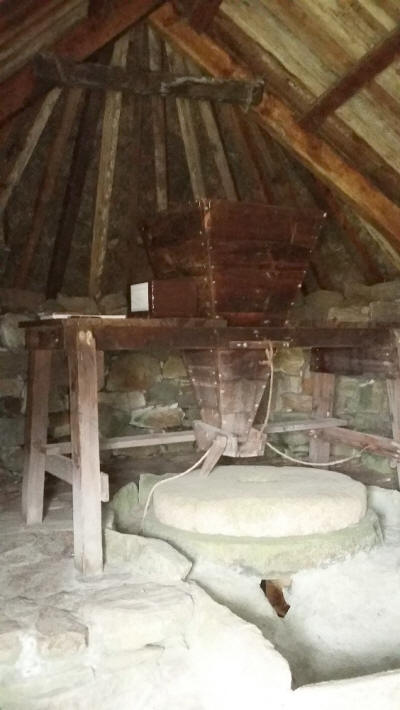 |
|
Water from the loch is channelled to the top of the
mill race just behind the mill. Here the land
slopes downward to the mill where the fast-flowing
water is used to turn the millstone. In the mill
undercroft the water drives a vertical shaft with a
set of paddles (tirl) beneath the mill floor which
directly drives the running stone. This is visible
through the gap in the undercroft wall that
accommodates the tail race. The tentering mechanism
can also be seen which comprises a simple lever
arrangement that raises the whole of the vertical
paddle shaft and running stone, so adjusting the
separation of the stones and hence the fineness of
the meal produced.
|
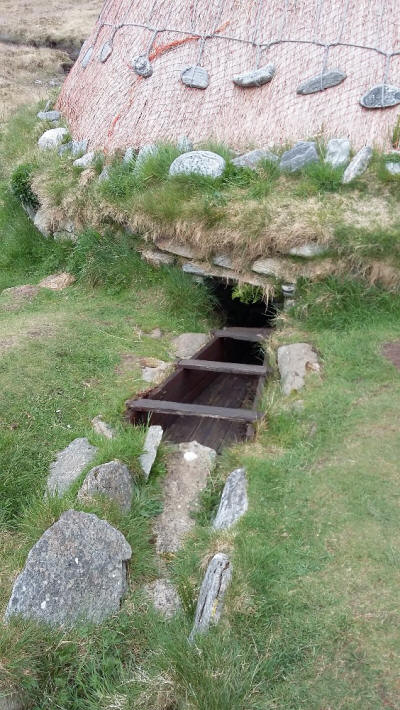 |
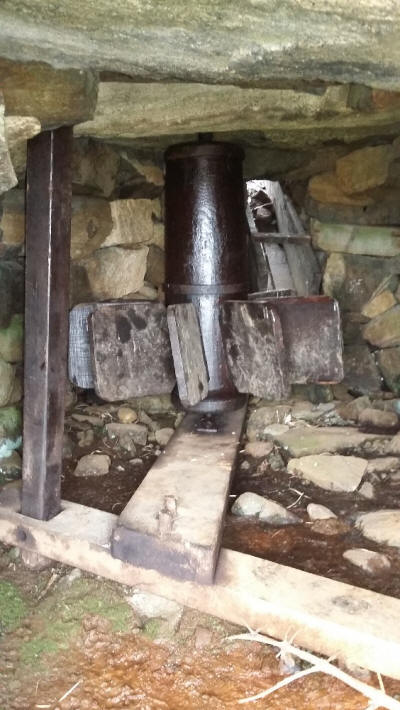 |
|

|
|
It is not obvious from
the diagram how the kiln operates. Externally there
is a channel which presumably provides fresh air for
the fire and drying process, something like a Roman
hypocaust. Inside there is a round stone-lined pit
which is connected to the outside channel. |
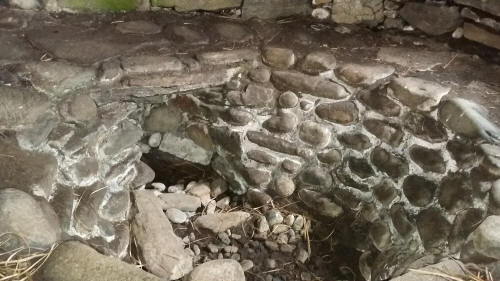
|
|
Clearly the grain would
be laid out to be dried in the building, although it
is not clear how this would have been arranged in
detail, but nonetheless the grain must have been
dried adequately to be milled effectively.
Editor: I suspect that there was some sort of
platform supported on the ledge above the bowl of
the kiln. This ledge is visible in the photograph,
but not in the diagram. |
|
|
